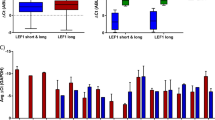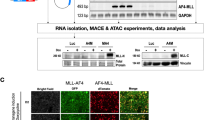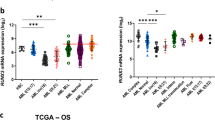Abstract
The t(8;21)(q22;q22) translocation, present in ∼5% of adult acute myeloid leukemia (AML) cases, produces the AML1/ETO (AE) fusion protein. Dysregulation of the Pit/Oct/Unc (POU) domain-containing transcription factor POU4F1 is a recurring abnormality in t(8;21) AML. In this study, we showed that POU4F1 overexpression is highly correlated with, but not caused by, AE. We observed that AE markedly increases the self-renewal capacity of myeloid progenitors from murine bone marrow or fetal liver and drives the expansion of these cells in liquid culture. POU4F1 is neither necessary nor sufficient for these AE-dependent properties, suggesting that it contributes to leukemia through novel mechanisms. To identify targets of POU4F1, we performed gene expression profiling in primary mouse cells with genetically defined levels of POU4F1 and identified 140 differentially expressed genes. This expression signature was significantly enriched in human t(8;21) AML samples and was sufficient to cluster t(8;21) AML samples in an unsupervised hierarchical analysis. Among the most highly differentially expressed genes, half are known AML1/ETO targets, implying that the unique transcriptional signature of t(8;21) AML is, in part, attributable to POU4F1 and not AML1/ETO itself. These genes provide novel candidates for understanding the biology and developing therapeutic approaches for t(8;21) AML.
This is a preview of subscription content, access via your institution
Access options
Subscribe to this journal
Receive 12 print issues and online access
$259.00 per year
only $21.58 per issue
Buy this article
- Purchase on Springer Link
- Instant access to full article PDF
Prices may be subject to local taxes which are calculated during checkout





Similar content being viewed by others
References
Zhang Y, Strissel P, Strick R, Chen J, Nucifora G, Le Beau MM et al. Genomic DNA breakpoints in AML1/RUNX1 and ETO cluster with topoisomerase II DNA cleavage and DNase I hypersensitive sites in t(8;21) leukemia. Proc Natl Acad Sci USA 2002; 99: 3070–3075.
Swerdlow SH, Campo E, Harris NL, Jaffe ES, Pileri SA, Stein H et al. WHO Classification of Tumours of Haematopoietic and Lymphoid Tissues. IARC: Lyon, 2008.
Meyers S, Lenny N, Hiebert SW . The t(8;21) fusion protein interferes with AML-1B-dependent transcriptional activation. Mol Cell Biol 1995; 15: 1974–1982.
Wang J, Hoshino T, Redner RL, Kajigaya S, Liu JM . ETO, fusion partner in t(8;21) acute myeloid leukemia, represses transcription by interaction with the human N-CoR/mSin3/HDAC1 complex. Proc Natl Acad Sci USA 1998; 95: 10860–10865.
Nucifora G, Larson RA, Rowley JD . Persistence of the 8;21 translocation in patients with acute myeloid leukemia type M2 in long-term remission. Blood 1993; 82: 712–715.
Higuchi M, O’Brien D, Kumaravelu P, Lenny N, Yeoh EJ, Downing JR . Expression of a conditional AML1-ETO oncogene bypasses embryonic lethality and establishes a murine model of human t(8;21) acute myeloid leukemia. Cancer Cell 2002; 1: 63–74.
Yuan Y, Zhou L, Miyamoto T, Iwasaki H, Harakawa N, Hetherington CJ et al. AML1-ETO expression is directly involved in the development of acute myeloid leukemia in the presence of additional mutations. Proc Natl Acad Sci USA 2001; 98: 10398–10403.
Fenske TS, Pengue G, Mathews V, Hanson PT, Hamm SE, Riaz N et al. Stem cell expression of the AML1/ETO fusion protein induces a myeloproliferative disorder in mice. Proc Natl Acad Sci USA 2004; 101: 15184–15189.
Valk PJ, Verhaak RG, Beijen MA, Erpelinck CA, Barjesteh van Waalwijk van Doorn-Khosrovani S, Boer JM et al. Prognostically useful gene-expression profiles in acute myeloid leukemia. N Engl J Med 2004; 350: 1617–1628.
Bullinger L, Dohner K, Bair E, Frohling S, Schlenk RF, Tibshirani R et al. Use of gene-expression profiling to identify prognostic subclasses in adult acute myeloid leukemia. N Engl J Med 2004; 350: 1605–1616.
He X, Treacy MN, Simmons DM, Ingraham HA, Swanson LW, Rosenfeld MG . Expression of a large family of POU-domain regulatory genes in mammalian brain development. Nature 1989; 340: 35–41.
Theil T, McLean-Hunter S, Zornig M, Moroy T . Mouse Brn-3 family of POU transcription factors: a new aminoterminal domain is crucial for the oncogenic activity of Brn-3a. Nucleic Acids Res 1993; 21: 5921–5929.
McEvilly RJ, Erkman L, Luo L, Sawchenko PE, Ryan AF, Rosenfeld MG . Requirement for Brn-3.0 in differentiation and survival of sensory and motor neurons. Nature 1996; 384: 574–577.
Xiang M, Gan L, Zhou L, Klein WH, Nathans J . Targeted deletion of the mouse POU domain gene Brn-3a causes selective loss of neurons in the brainstem and trigeminal ganglion, uncoordinated limb movement, and impaired suckling. Proc Natl Acad Sci USA 1996; 93: 11950–11955.
Quina LA, Pak W, Lanier J, Banwait P, Gratwick K, Liu Y et al. Brn3a-expressing retinal ganglion cells project specifically to thalamocortical and collicular visual pathways. J Neurosci 2005; 25: 11595–11604.
Hanson P, Mathews V, Marrus SH, Graubert TA . Enhanced green fluorescent protein targeted to the Sca-1 (Ly-6A) locus in transgenic mice results in efficient marking of hematopoietic stem cells in vivo. Exp Hematol 2003; 31: 159–167.
Irizarry RA, Bolstad BM, Collin F, Cope LM, Hobbs B, Speed TP . Summaries of Affymetrix GeneChip probe level data. Nucleic Acids Res 2003; 31: e15.
Huang da W, Sherman BT, Lempicki RA . Systematic and integrative analysis of large gene lists using DAVID bioinformatics resources. Nat Protoc 2009; 4: 44–57.
Tomasson MH, Xiang Z, Walgren R, Zhao Y, Kasai Y, Miner T et al. Somatic mutations and germline sequence variants in the expressed tyrosine kinase genes of patients with de novo acute myeloid leukemia. Blood 2008; 111: 4797–4808.
Smedley D, Haider S, Ballester B, Holland R, London D, Thorisson G et al. BioMart—biological queries made easy. BMC Genomics 2009; 10: 22.
Subramanian A, Tamayo P, Mootha VK, Mukherjee S, Ebert BL, Gillette MA et al. Gene set enrichment analysis: a knowledge-based approach for interpreting genome-wide expression profiles. Proc Natl Acad Sci USA 2005; 102: 15545–15550.
Tusher VG, Tibshirani R, Chu G . Significance analysis of microarrays applied to the ionizing radiation response. Proc Natl Acad Sci USA 2001; 98: 5116–5121.
Bullinger L, Rucker FG, Kurz S, Du J, Scholl C, Sander S et al. Gene-expression profiling identifies distinct subclasses of core binding factor acute myeloid leukemia. Blood 2007; 110: 1291–1300.
Ichikawa H, Tanabe K, Mizushima H, Hayashi Y, Mizutani S, Ishii E et al. Common gene expression signatures in t(8;21)- and inv(16)-acute myeloid leukaemia. Br J Haematol 2006; 135: 336–347.
Schoch C, Kohlmann A, Schnittger S, Brors B, Dugas M, Mergenthaler S et al. Acute myeloid leukemias with reciprocal rearrangements can be distinguished by specific gene expression profiles. Proc Natl Acad Sci USA 2002; 99: 10008–10013.
Debernardi S, Lillington DM, Chaplin T, Tomlinson S, Amess J, Rohatiner A et al. Genome-wide analysis of acute myeloid leukemia with normal karyotype reveals a unique pattern of homeobox gene expression distinct from those with translocation-mediated fusion events. Genes Chromosomes Cancer 2003; 37: 149–158.
Ross ME, Mahfouz R, Onciu M, Liu HC, Zhou X, Song G et al. Gene expression profiling of pediatric acute myelogenous leukemia. Blood 2004; 104: 3679–3687.
Miyamoto T, Weissman IL, Akashi K . AML1/ETO-expressing nonleukemic stem cells in acute myelogenous leukemia with 8;21 chromosomal translocation. Proc Natl Acad Sci USA 2000; 97: 7521–7526.
Grisolano JL, O’Neal J, Cain J, Tomasson MH . An activated receptor tyrosine kinase, TEL/PDGFbetaR, cooperates with AML1/ETO to induce acute myeloid leukemia in mice. Proc Natl Acad Sci USA 2003; 100: 9506–9511.
de Guzman CG, Warren AJ, Zhang Z, Gartland L, Erickson P, Drabkin H et al. Hematopoietic stem cell expansion and distinct myeloid developmental abnormalities in a murine model of the AML1-ETO translocation. Mol Cell Biol 2002; 22: 5506–5517.
Shimada H, Ichikawa H, Ohki M . Potential involvement of the AML1-MTG8 fusion protein in the granulocytic maturation characteristic of the t(8;21) acute myelogenous leukemia revealed by microarray analysis. Leukemia 2002; 16: 874–885.
Tonks A, Pearn L, Musson M, Gilkes A, Mills KI, Burnett AK et al. Transcriptional dysregulation mediated by RUNX1-RUNX1T1 in normal human progenitor cells and in acute myeloid leukaemia. Leukemia 2007; 21: 2495–2505.
Gardini A, Cesaroni M, Luzi L, Okumura AJ, Biggs JR, Minardi SP et al. AML1/ETO oncoprotein is directed to AML1 binding regions and co-localizes with AML1 and HEB on its targets. PLoS Genet 2008; 4: e1000275.
Yeh JR, Munson KM, Chao YL, Peterson QP, Macrae CA, Peterson RT . AML1-ETO reprograms hematopoietic cell fate by downregulating scl expression. Development 2008; 135: 401–410.
Su AI, Wiltshire T, Batalov S, Lapp H, Ching KA, Block D et al. A gene atlas of the mouse and human protein-encoding transcriptomes. Proc Natl Acad Sci USA 2004; 101: 6062–6067.
Nichols J, Zevnik B, Anastassiadis K, Niwa H, Klewe-Nebenius D, Chambers I et al. Formation of pluripotent stem cells in the mammalian embryo depends on the POU transcription factor Oct4. Cell 1998; 95: 379–391.
Niwa H, Miyazaki J, Smith AG . Quantitative expression of Oct-3/4 defines differentiation, dedifferentiation or self-renewal of ES cells. Nat Genet 2000; 24: 372–376.
Jin T, Branch DR, Zhang X, Qi S, Youngson B, Goss PE . Examination of POU homeobox gene expression in human breast cancer cells. Int J Cancer 1999; 81: 104–112.
Cheng L . Establishing a germ cell origin for metastatic tumors using OCT4 immunohistochemistry. Cancer 2004; 101: 2006–2010.
Hochedlinger K, Yamada Y, Beard C, Jaenisch R . Ectopic expression of Oct-4 blocks progenitor-cell differentiation and causes dysplasia in epithelial tissues. Cell 2005; 121: 465–477.
Budram-Mahadeo V, Morris PJ, Latchman DS . The Brn-3a transcription factor inhibits the pro-apoptotic effect of p53 and enhances cell cycle arrest by differentially regulating the activity of the p53 target genes encoding Bax and p21(CIP1/Waf1). Oncogene 2002; 21: 6123–6131.
Hudson CD, Sayan AE, Melino G, Knight RA, Latchman DS, Budhram-Mahadeo V . Brn-3a/POU4F1 interacts with and differentially affects p73-mediated transcription. Cell Death Differ 2008; 15: 1266–1278.
Ma L, Lei L, Eng SR, Turner E, Parada LF . Brn3a regulation of TrkA/NGF receptor expression in developing sensory neurons. Development 2003; 130: 3525–3534.
Mulloy JC, Jankovic V, Wunderlich M, Delwel R, Cammenga J, Krejci O et al. AML1-ETO fusion protein up-regulates TRKA mRNA expression in human CD34+ cells, allowing nerve growth factor-induced expansion. Proc Natl Acad Sci USA 2005; 102: 4016–4021.
Schilham MW, Oosterwegel MA, Moerer P, Ya J, de Boer PA, van de Wetering M et al. Defects in cardiac outflow tract formation and pro-B-lymphocyte expansion in mice lacking Sox-4. Nature 1996; 380: 711–714.
Cheung M, Abu-Elmagd M, Clevers H, Scotting PJ . Roles of Sox4 in central nervous system development. Brain Res Mol Brain Res 2000; 79: 180–191.
Schilham MW, Moerer P, Cumano A, Clevers HC . Sox-4 facilitates thymocyte differentiation. Eur J Immunol 1997; 27: 1292–1295.
Graham JD, Hunt SM, Tran N, Clarke CL . Regulation of the expression and activity by progestins of a member of the SOX gene family of transcriptional modulators. J Mol Endocrinol 1999; 22: 295–304.
Bangur CS, Switzer A, Fan L, Marton MJ, Meyer MR, Wang T . Identification of genes over-expressed in small cell lung carcinoma using suppression subtractive hybridization and cDNA microarray expression analysis. Oncogene 2002; 21: 3814–3825.
Ahn SG, Cho GH, Jeong SY, Rhim H, Choi JY, Kim IK . Identification of cDNAs for Sox-4, an HMG-Box protein, and a novel human homolog of yeast splicing factor SSF-1 differentially regulated during apoptosis induced by prostaglandin A2/delta12-PGJ2 in Hep3B cells. Biochem Biophys Res Commun 1999; 260: 216–221.
Pan X, Zhao J, Zhang WN, Li HY, Mu R, Zhou T et al. Induction of SOX4 by DNA damage is critical for p53 stabilization and function. Proc Natl Acad Sci USA 2009; 106: 3788–3793.
Boyd KE, Xiao YY, Fan K, Poholek A, Copeland NG, Jenkins NA et al. Sox4 cooperates with Evi1 in AKXD-23 myeloid tumors via transactivation of proviral LTR. Blood 2006; 107: 733–741.
Syme CA, Zhang L, Bisello A . Caveolin-1 regulates cellular trafficking and function of the glucagon-like Peptide 1 receptor. Mol Endocrinol 2006; 20: 3400–3411.
Pang A, Au WY, Kwong YL . Caveolin-1 gene is coordinately regulated with the multidrug resistance 1 gene in normal and leukemic bone marrow. Leuk Res 2004; 28: 973–977.
Wong K, Ren XR, Huang YZ, Xie Y, Liu G, Saito H et al. Signal transduction in neuronal migration: roles of GTPase activating proteins and the small GTPase Cdc42 in the Slit-Robo pathway. Cell 2001; 107: 209–221.
Wang B, Xiao Y, Ding BB, Zhang N, Yuan X, Gui L et al. Induction of tumor angiogenesis by Slit-Robo signaling and inhibition of cancer growth by blocking Robo activity. Cancer Cell 2003; 4: 19–29.
Marlow R, Strickland P, Lee JS, Wu X, Pebenito M, Binnewies M et al. SLITs suppress tumor growth in vivo by silencing Sdf1/Cxcr4 within breast epithelium. Cancer Res 2008; 68: 7819–7827.
Bernard-Pierrot I, Gruel N, Stransky N, Vincent-Salomon A, Reyal F, Raynal V et al. Characterization of the recurrent 8p11-12 amplicon identifies PPAPDC1B, a phosphatase protein, as a new therapeutic target in breast cancer. Cancer Res 2008; 68: 7165–7175.
Acknowledgements
This study was supported by funding from the NIH (P01 CA101937) and Gabrielle's Angel Foundation. Cell sorting and gene expression profiling were performed in Siteman Cancer Center core facilities that are supported by the NCI (P30 CA91842). We thank Eric Turner and Michael Tomasson for providing critical reagents (plasmids and mutant mice) and Mieke Hoock for expert mouse colony management.
Author information
Authors and Affiliations
Corresponding author
Ethics declarations
Competing interests
The authors declare no conflict of interest.
Additional information
Supplementary Information accompanies the paper on the Leukemia website
Rights and permissions
About this article
Cite this article
Fortier, J., Payton, J., Cahan, P. et al. POU4F1 is associated with t(8;21) acute myeloid leukemia and contributes directly to its unique transcriptional signature. Leukemia 24, 950–957 (2010). https://doi.org/10.1038/leu.2010.61
Received:
Revised:
Accepted:
Published:
Issue Date:
DOI: https://doi.org/10.1038/leu.2010.61
Keywords
This article is cited by
-
AML1/ETO and its function as a regulator of gene transcription via epigenetic mechanisms
Oncogene (2021)
-
Stability of gene expression and epigenetic profiles highlights the utility of patient-derived paediatric acute lymphoblastic leukaemia xenografts for investigating molecular mechanisms of drug resistance
BMC Genomics (2014)
-
Notch signaling in acute promyelocytic leukemia
Leukemia (2013)
-
The role of SRY-related HMG box transcription factor 4 (SOX4) in tumorigenesis and metastasis: friend or foe?
Oncogene (2013)
-
AML1/ETO and POU4F1 synergy drives B-lymphoid gene expression typical of t(8;21) acute myeloid leukemia
Leukemia (2012)



